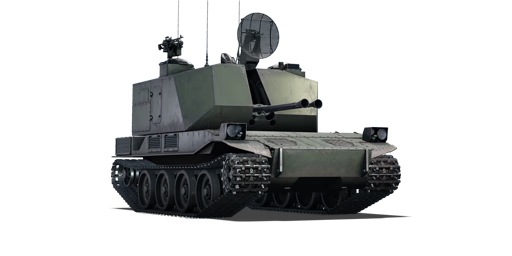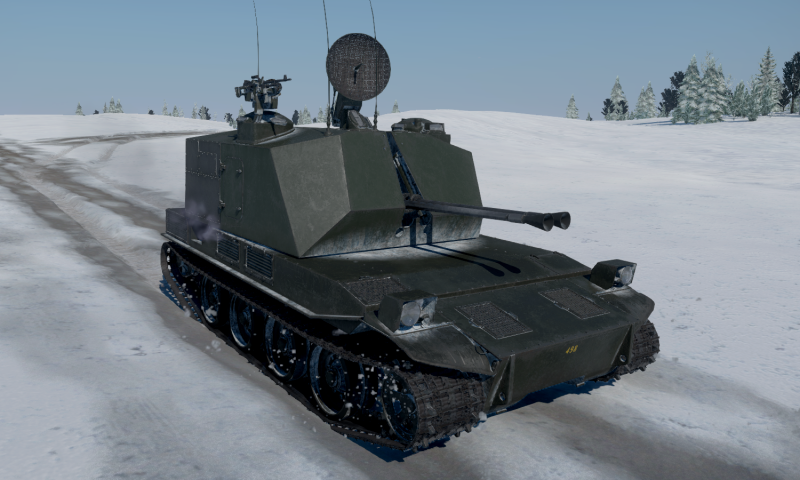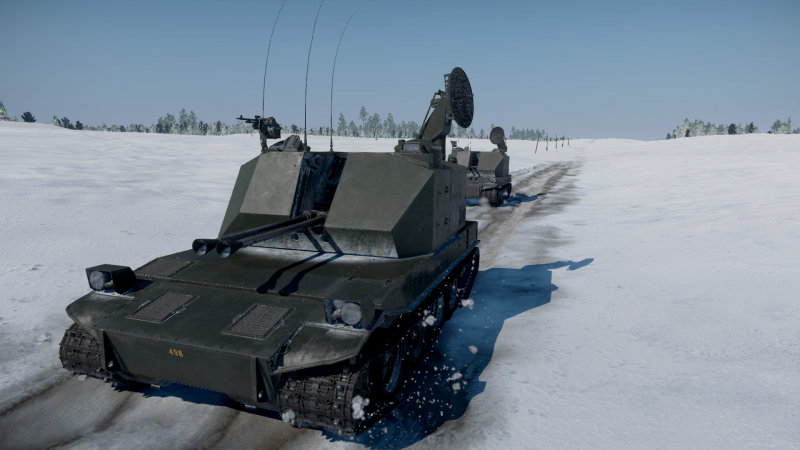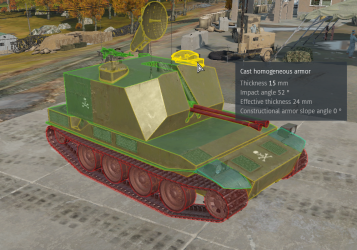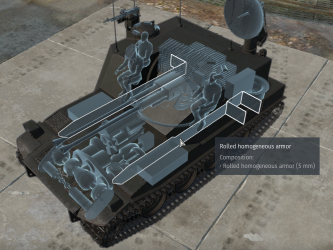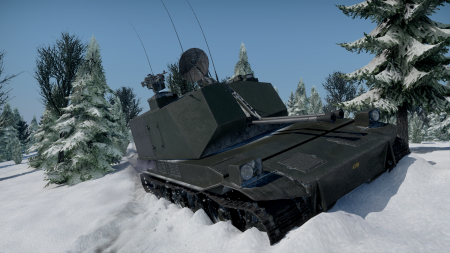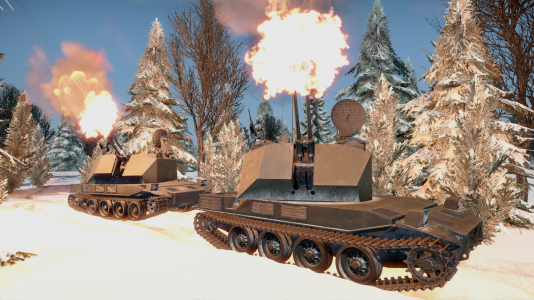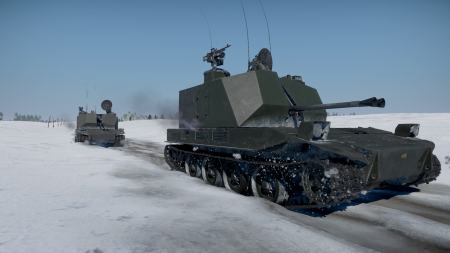Difference between revisions of "VEAK 40"
U119469481 (talk | contribs) (No more HEVT ):) (Tag: Visual edit) |
U111512537 (talk | contribs) (They removed the proxy shells [Nerf] . It is also basically trash not, definetly worse than the itpsv 90 because of its inaccuracy and slow firing rate.) (Tag: Visual edit) |
||
| Line 161: | Line 161: | ||
* Radar is a Combined Search and Tracking radar, can track targets through a full 360°, will not randomly alert other aircraft while focusing on one | * Radar is a Combined Search and Tracking radar, can track targets through a full 360°, will not randomly alert other aircraft while focusing on one | ||
* Radar folds back when turned off, reducing profile | * Radar folds back when turned off, reducing profile | ||
| − | |||
'''Cons:''' | '''Cons:''' | ||
| − | * Inaccurate | + | * Inaccurate |
* Both guns use the same belts, meaning ammo will run out twice as fast than what UI tries to convey | * Both guns use the same belts, meaning ammo will run out twice as fast than what UI tries to convey | ||
* Very easy to destroy since all the ammo and the crew are located in the turret | * Very easy to destroy since all the ammo and the crew are located in the turret | ||
Revision as of 13:46, 1 May 2024
Contents
Description
The VEAK 40 was developed by the Swedish arms manufacturer Bofors by request of the Swedish army as a 1960s next generation Swedish SPAA following the 1940s limited production Lvkv fm/43 SPAA and failed 1950s Lvkv 42 prototype SPAA. A single prototype based on the Strv 103 chassis was built and delivered for testing in 1964. The project was delayed at this point but testing commenced and the vehicle proved to be ahead of its time regarding armament and fire control system. This however made the vehicle too costly and in the end the project had to be scrapped due to resources going to the Swedish air force rather than the Swedish air defense. The name VEAK 40 follows Bofors naming scheme, not the Swedish army's naming scheme. Its full historical Bofors-name was Bofors VEAK 40 X 60, VEAK indicating type (tracked vehicle with FC-radar and autocannons), 40 indicating calibre (40 mm) and 60 indicating year of design (1960).
The Vagn Eldledning AutomatKanon 40 (English: "Wagon Fire-control AutoCannon 40"), or VEAK 40 for short, was introduced in Update 1.97 "Viking Fury". It's armed with two 40 mm Bofors L/70 autocannons (Swedish designation: lvakan m/48) which each have a fire rate of 300 rounds per minute. It has mediocre mobility and subpar protection but does feature excellent vertical and horizontal traverse speed for the guns. It also comes equipped with a tracking and search radar that allows the player to find and track airborne targets within a 12 km radius.
General info
Survivability and armour
| External armour on the VEAK 40 | Internal armour on the VEAK 40 |
The frontal armour of the VEAK 40 is roughly 15 mm thick all around with very limited sloping angles to back it up. The gun mantlet, roof of both hull and turret, as well as the back are 5 mm thick and vulnerable even to 40 mm HE, as well as 7.62 mm MG at flat angles.
Heavy machine guns can knock it out by firing at the turret from all directions. The turret is also very big and boxy and also houses all of the vehicles ammunition and crew, thus a shot there usually results in an ammo rack detonation.
The hull however is fairly empty of components and only houses the transmission and engine which are located in their own compartment, resulting in tons of empty space in the hull under the turret. There is also a small internal screen to protect the turret compartment from stray shots. Attack to the lower hull usually leaves the vehicle combat capable.
The radar is placed too high to let vehicle hide behind a hill line, but it can be turned off and hidden behind the SPAA to reduce probability of a hit.
Armour type:
- Rolled homogeneous armour
- Cast homogeneous armour (Cupolas)
- Structural steel (Radar mast, Radar dish, Mud skirts, Suspension)
| Armour | Front (Slope°) | Sides [Internal] (Slope°) | Rear (Slope°) | Roof (Slope°) |
|---|---|---|---|---|
| Hull | 5-15 mm (77°) Front glacis 15 mm (18-71°) Lower glasis |
5-15 mm [+5 mm] Upper sides 15 mm Lower sides |
15 mm Upper rear 15 mm (13°) Lower rear |
15 mm (90°) Roof 4 mm (29-77°) Mud skirts |
| Turret | 15 mm (25°) Upper right sheek 15 mm Upper left sheek 15 mm (26°) Upper right front 15 mm (41°) Upper left front 15 mm (17°) Lower front |
5 mm (74°) Upper sides 15 mm Forward sides 5 mm Backward sides |
5 mm (73°) Upper rear 5 mm Lower rear |
5 mm Roof 15 mm (0-35°) Radar mast 15 mm (0-68°) Radar dish |
| Cupola | 15 mm | 15 mm | 15 mm | 15 mm (44-83°) Cupola dome |
Notes:
- Suspension wheels, tracks and torsion bars are 20 mm thick.
Mobility
| Game Mode | Max Speed (km/h) | Weight (tons) | Engine power (horsepower) | Power-to-weight ratio (hp/ton) | |||
|---|---|---|---|---|---|---|---|
| Forward | Reverse | Stock | Upgraded | Stock | Upgraded | ||
| Arcade | Expression error: Unexpected * operator. | 767 | Expression error: Unexpected round operator. | __.__ | |||
| Realistic | 478 | Expression error: Unexpected round operator. | __.__ | ||||
The mobility of the VEAK 40 is excellent. The vehicle is based on the chassis of the Strv 103A and features the same transmission and engine (although currently lacking turbine engine sound) while being 7.9 tons lighter. The engine gives out 540 hp in realistic when fully upgraded, giving this 29 ton vehicle a power to ton ratio of 18.62. This gives the tank great acceleration on shorter distances and allows it to effectively move around the battlefield like the average speedy light tank.
Mobility times on flat paved terrain (realistic)
- Time to 60 km/h (max effective) forward: > 25 s
- Time to 20 km/h forward: > 2 s
- Time to 18 km/h (max effective) reverse: > 2 s
- Time to rotate 360°: < 8 s
Mobility times on flat grass terrin (realistic)
- Time to 40 km/h (max effective) forward: < 11 s
- Time to 20 km/h forward: > 2 s
- Time to 18 km/h (max effective) reverse: > 2 s
- Time to rotate 360°: < 8 s
Armaments
Main armament
The VEAK 40 uses two Bofors 40 mm anti-aircraft autocannon L/70 guns, in Swedish service designated 40 mm lvakan m/48. These have extremely good stats in all regards. Excellent rate of fire, excellent velocity and excellent effect against both aircraft and tanks.
The downside compared to 35 mm counterparts is the questionable accuracy. It is also really easy to spend half of the ammunition without even noticing - each gun consumes a clip every 10 shots, but the UI presents it as 20 shots in the same box, which might be confusing. To avoid confusion, always divide current amount of clips by 2.
| 40 mm lvakan m/48 (x2) | Turret rotation speed (°/s) | Reloading rate (seconds) | ||||||||||||
|---|---|---|---|---|---|---|---|---|---|---|---|---|---|---|
| Mode | Capacity (Belt) | Fire rate | Vertical | Horizontal | Stabilizer | Stock | Upgraded | Full | Expert | Aced | Stock | Full | Expert | Aced |
| Arcade | 420 (10) | 300 | -5°/+85° | ±180° | Two-plane | 74.9 | 103.6 | 125.8 | 139.1 | 148.0 | 0.65 | 0.58 | 0.53 | 0.50 |
| Realistic | 50.6 | 59.5 | 72.2 | 79.9 | 85.0 | |||||||||
Ammunition
The ammunition of the VEAK 40 is below average for its type. The penetration values even of the AP ammunition is too low to penetrate any heavy tank, but it can penetrate lighter tanks through weak spots in the majority of situations.
- Default: SAPHEI · HEFI-T
- slsgr m/484: HE-VT* · HE-VT* · HE-VT*
| Penetration statistics | |||||||
|---|---|---|---|---|---|---|---|
| Ammunition | Penetration @ 0° Angle of Attack (mm) | ||||||
| 10 m | 100 m | 500 m | 1,000 m | 1,500 m | 2,000 m | ||
| SAPHEI | 68 | 64 | 49 | 35 | 25 | 18 | |
| HEFI-T | 9 | 9 | 8 | 6 | 5 | 4 | |
| AP | 95 | 90 | 72 | 55 | 42 | 32 | |
| Shell details | ||||||||||||
|---|---|---|---|---|---|---|---|---|---|---|---|---|
| Ammunition | Velocity (m/s) |
Projectile mass (kg) |
Fuse delay (m) |
Fuse sensitivity (mm) |
Explosive mass (TNT equivalent) (g) |
Ricochet | ||||||
| 0% | 50% | 100% | ||||||||||
| SAPHEI | 880 | 1 | 1.2 | 9 | 38 | 79° | 80° | 81° | ||||
| HEFI-T | 850 | 1 | 0.1 | 0.1 | 44 | 79° | 80° | 81° | ||||
| AP | 910 | 1.2 | - | - | - | 47° | 60° | 65° | ||||
Ammo racks
| Full ammo |
1st rack empty |
2nd rack empty |
Visual discrepancy |
|---|---|---|---|
| 42 | 30 (+12) | 11 (+31) | No |
Machine guns
Beyond its main weaponry, the VEAK 40 also features a cupola mounted 7,62 mm FN MAG machine gun, in Swedish service designated 7,62 mm ksp m/58B. This is extremely rare for SPAAs and makes it one of two SPAAs that has a secondary machine gun (the other one being the Lvkv 9040C). Due to the characteristics of its main weaponry there is rarely a need to use the secondary machine gun, but it can be used when suppressing ATGM carriers or low flying helicopters (as VT shell requires 500 m range to activate and will not disable them at close range).
| 7.62 mm ksp 58 | ||||
|---|---|---|---|---|
| Mount | Capacity (Belt) | Fire rate | Vertical | Horizontal |
| Pintle | 1,000 (250) | 600 | -10°/+50° | ±120° |
Usage in battles
The VEAK 40 is a fairly basic tier 5 SPAA. It has a radar and anti air guns that can take out any aircraft within 3 km. The guns also has fairly high penetration on its armour-piercing ammo and will easily take out lightly armoured vehicles in the front and the majority of vehicles in the side. Its protection is more or less non-existent and the VEAK 40 can even be dealt with using regular low-calibre machine guns.
When playing the VEAK 40 it is best to stay in spawn and shoot at incoming aircraft, or using the great mobility to follow team-mates into battle and support them with suppressive fire and anti-aircraft support. If there are no aircraft to shoot at then it is viable to cruise around the map at high speeds and hunt lightly armored targets and capture points.
Due to the large profile of the turret there are rarely options for hiding behind cover and thus it is best to play aggressively and using your high speed, stabilized guns and high fire rate to defeat enemy tanks. The radar mast retracts behind the turret like on a lot of other radar SPAAs when turned off, allowing you to become slightly less visible. Turning it off may be a good choice, if you are not looking to be spotted as easily if you believe enemies may be nearby.
Pros and cons
Pros:
- Twin 40 mm lvakan m/48 cannons are very effective against air units
- Has a lot of meaningful options for ammo belts:
- Has SAPHEI/HE belt like the early Swedish SPAA to obliterate poorly armoured vehicles and exploit weak spots
- AP belt has 3/1 composition and can penetrate medium battle tanks hulls from the side with some effort given
- Has a pintle-mounted machine gun for maximum suppressing fire, unlike other SPAA
- Radar is a Combined Search and Tracking radar, can track targets through a full 360°, will not randomly alert other aircraft while focusing on one
- Radar folds back when turned off, reducing profile
Cons:
- Inaccurate
- Both guns use the same belts, meaning ammo will run out twice as fast than what UI tries to convey
- Very easy to destroy since all the ammo and the crew are located in the turret
- The turret's armour is very thin (only 5 mm covering mantlet, roof and sides)
- Can be taken out by even rifle-calibre machine guns
- Radar has poor range, compared to others of its type, prone to collisions when fighting multiple aircraft in close proximity
- Can be easily spotted due to a large turret profile and tall radar mast
- Engine is very loud, can easily give away your position while moving
- Not as versatile as the ItPsV 90, with its poor silhouette, speed, and AP options it generally ends up being used solely as AA
History
The VEAK 40 was an experimental SPAA developed by Landsverk and Bofors. It was made in 1964 and retired in the late 70s? The VEAK 40 in real life and in War Thunder had HEVT shells, however HEVT shells were removed for balancing purposes (despite ruining the Swedish SPAA line)
Media
- Skins
See also
- Other vehicles of similar configuration and role
External links
Paste links to sources and external resources, such as:
- topic on the official game forum;
- other literature.
| AB Bofors | |
|---|---|
| MBTs | |
| Strv 103 | Strv 103-0 · Strv 103A · Strv 103С |
| Tank Destroyers | SAV 20.12.48 · Bkan 1C |
| SPAA | Lvkv 42 |
| Radar | VEAK 40 |
| SAM | ASRAD-R* |
| See Also | BAE Systems AB |
| *Saab Bofors Dynamics | |
| Sweden anti-aircraft vehicles | |
|---|---|
| SPAA | Pvlvv fm/42 · Lvtdgb m/40 · Pbv 301 · Lvkv 42 · U-SH 204 GK |
| Radar SPAA | VEAK 40 · Lvkv 9040C |
| SAM | Lvrbv 701 · ASRAD-R |
| Finland | L-62 ANTI II · ▄ZSU-57-2 · ItO 90M · ItPsV Leopard |


